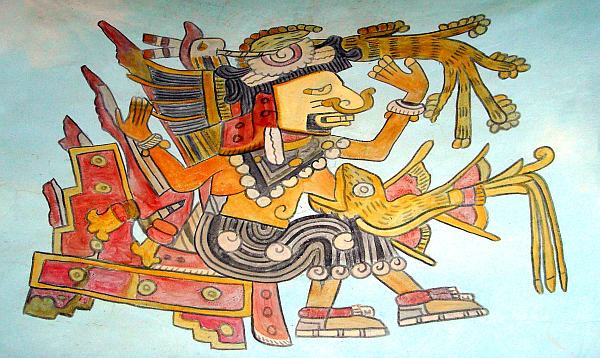Mexico - Other than knowing a good margarita when I taste one, I know little about tequila and its cousin, mezcal. Of course I realize they are not the same, but after that my knowledge quickly wanes.
I am sure there are many readers who have the ability to spout multiple facts and figures about the subject, but for those of us who have spent more time drinking these liquids than reading about them, maybe we can catch up a little.
It all began with Mayahuel, the Aztec goddess who bore 400 gods, provided sustenance to Mexico’s people and from her bosom oozed the first alcoholic drink of the Americas. Known as pulque, this 2000 year-old, white, foamy, viscous beverage of four to eight percent alcohol is the mother of mezcal and the abuelita of tequila. Mayahuel is often depicted with many breasts to feed her many children.
From the milky sap of the maguey (pronounced muh-GAY) plant the alcoholic drink pulque (pronounced POOL-ke) was brewed. Pulque was used by the royalty and priesthood on special days of religious celebration and to celebrate great victories. Many references to the use of pulque in pre-Hispanic celebrations have been found in hieroglyphic references.
In order to control the consumption of pulque by the general populace, native rulers prohibited the use of pulque by anyone except the elderly, nursing mothers, and the ruling class during high religious festivals. People who disregarded this law paid a heavy penalty.
Drunkenness amongst commoners was punished by the public humiliation of shaved heads and a good beating. Second offenses were less complicated with the offender being put to death. The one exception was the "days of the dead" at the end of the calendar year which signaled a five day binge in which all participated.
The Aztec people had been making this fermented beverage from the agave plant long before the Spanish arrived in 1521. When the Spaniards arrived they brought with them brandy, their beverage of choice. However, they quickly consumed all they had brought.
As the early Spaniards searched for a source of fermentable sugar for the production of distilled spirits, they looked to the agave plant, which grew in abundance in the rich volcanic soils of the high valleys around Guadalajara.
Trial and error led them to one particular species that always seemed to produce the most full-bodied taste. This special plant was the Agave Tequilana Weber, the legendary blue agave, or agave azul. The distilled pulque was called mezcal wine and agave wine. It was the first distilled drink in North America.
 |
In 1758 the King of Spain granted José Antonio Cuervo the rights to cultivate a parcel of land in the Jalisco region. In 1795, King Carlos IV gave the land grant to Cuervo’s descendant, Jose María Guadalupe Cuervo. Carlos IV also granted the Cuervo family the first license to commercially make tequila.
The family started packaging their tequila in individual bottles in 1880. The agave fields have been growing in numbers on their land ever since. Cuervo remains the largest producer and exporter of tequila today.
In 1858, Don Cenobio Sauza visited the town of Tequila and quickly fell in love with this magical place. He gained skills in agave farming and learned about production while working at the Cuervo Distillery. He later bought his own distillery and founded Sauza Tequila, becoming one of Cuervo’s great rivals.
Although there are many varieties of maguey (agave) plants, about six are best for producing pulque (mezcal). The agave tequila or blue agave, the variety used by the Spaniards, is a native of Jalisco, Mexico. The blue agave used to make tequila can legally be grown in only five areas in Mexico: The entire state of Jalisco, plus small parts of Tamaulipas, Nayarit, Guanajuato, and Michoacan. This is Tequila Country.
The remaining varieties are found throughout Mexico, although most commercial mezcal is produced around the city of Oaxaca in the mountainous southern part of Mexico. Mexican law passed in 1994 now protects the name mezcal from being applied to products made from anything except the allowed and approved agave plants. Only six municipos (counties) can legally manufacture a drink named mezcal, all near the city of Oaxaca.
Mezcal can be made from up to 28 recognized species and varieties of agave. However, 90 percent of mezcal currently produced is made from the Espadin Agave variety (Agave Angustifolia.) Tequila can only be made from Agave Tequilana Weber (Blue Agave.)
In addition to different varieties of agave used in making the liquor, the production process between tequila and mezcal are also different.
The part of the plant that is used to make the drink is the heart (root), or piña, which looks like a large pineapple or pinecone. If tequila is being made, the piña is quartered and slowly baked in steam ovens until all starches are converted to sugars. The oven cooking is slow with the steam injection lasting from 36 to 48 hours.
Mezcal is produced on a much smaller scale with the use of open pit ovens, which are literally earthen mounds over pits of hot rocks. The cut pieces of piña are baked in these ovens for about three days. This underground roasting gives mezcal its intense and distinctive smoky flavor. Mezcal is not as smooth as tequila, as it is generally distilled only once while tequila is distilled twice.
Not all bottles of mezcal contain the famous "worm" (actually a larva that can infest maguey plants), but if added, it is added during the bottling process. There are conflicting stories as to why a worm would be added. Some state that it is a marketing ploy. Others state that it is there to prove that the mezcal is fit to drink, and still others state that the larva is there to impart flavor.
So comes the phrase, "All tequila is mezcal, but all mezcal is not tequila."


